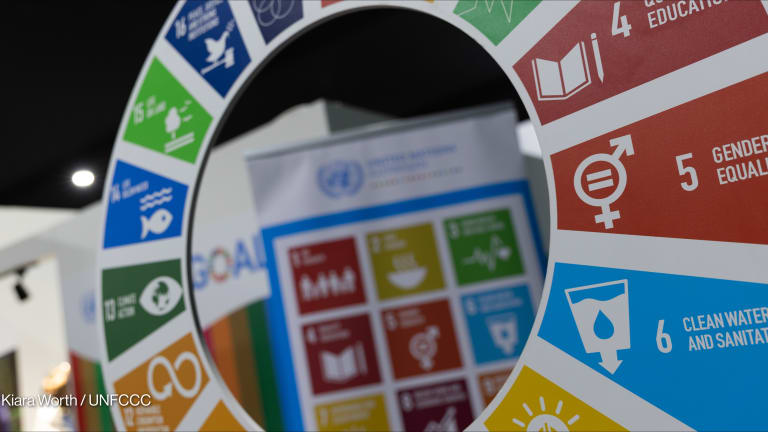UN's effort to map internet access from space expands beyond schools
As part of an effort called Giga, UNICEF is using satellite imagery to map the location and internet connection of schools. Africa CDC is now repurposing the technology and approach for health clinics.
An innovative approach to connect every school in the world to the internet is now being repurposed for health clinics. Since 2019, Project Connect has mapped the location of 2.1 million schools globally, as well as the internet connection and network quality of more than 330,000 schools. The goal is to highlight connectivity gaps so that governments have the information they need to get more schools online, often by bringing in outside investment. The data it collects underpins Giga, a joint initiative of UNICEF and the International Telecommunication Union, a United Nations agency focused on expanding access to information and communication technology. Now, the Africa Centres for Disease Control and Prevention is using the same technology and strategy to map and connect tens of thousands of health facilities across the African continent — with the hope of attracting investment. Chris Fabian, co-founder and co-lead of Giga, and Jean-Philbert Nsengimana, chief digital advisor for Africa CDC, shared the news in a recent Twitter Space hosted by Devex about closing the digital divide. “The idea that Giga had, which was, ‘let’s map all these schools, show their connectivity, and use that to build financing,’ that applies equally well to other buildings,” Fabian said. “Some of those same methods we’ve used in the education space we hope will be used by others, including the Africa CDC, using the same tech stack.” The emerging partnership between Giga and the Africa CDC points to how open-source tools can enable collaboration across sectors to connect the 2.7 billion people worldwide who still do not have internet access. Mapping schools In addition to mapping internet access in real time, Giga creates innovative financing models and supports government contracting for connectivity. The effort has helped governments in low- and middle-income countries raise more than $600 million, including loans from development finance institutions and international financial institutions, government connectivity funds, and donations ranging from telecommunications giant Ericsson to the Musk Foundation, the charity of SpaceX and Twitter CEO Elon Musk. Giga plans to connect more than 25,000 schools over the next 18 months. It expects it will cost $428 billion to connect the estimated 6 million schools globally by 2030. Giga uses artificial intelligence and machine learning models to find schools on satellite imagery, then layers that data with maps of fiber internet access and mobile coverage. Information on the school’s connectivity status and the quality of internet service is uploaded and displayed on Project Connect’s open data platform, said Naroa Zurutuza, technology lead at Giga. With this information, governments can do things like verify whether internet service providers and mobile network operators are delivering on contracts to connect these communities to the internet. UNICEF, which develops all of its technology as open-source tools, took the same approach with Project Connect. “We built these models for schools, but you could adapt them for other public health facilities,” Zurutuza said. The code for this work is available on a public Github repository that anyone can download and build on top of. Another open-source technology developed for Giga is an app that schools can install in a laptop or other device that measures the internet access of a particular location. That same app could similarly be installed in health centers or other public facilities. Adopting the model When government leaders can look at a map of green and red dots showing which schools are and aren’t connected, “it becomes an entirely different conversation,” said Fabian of Giga. Africa CDC will use Giga’s technology to identify the location and internet connection of health centers from satellite imagery. “We will align with Giga on their pilot countries,” and “adopt the partnership and financing models they have developed,” Nsengimana told Devex by email. Africa CDC is repurposing the Giga model as part of its effort to connect African health facilities, and 1 million community health workers, to the internet by 2030. One of the major barriers to closing the digital divide has to do with coordination, he explained in the Twitter Space. It’s a missed opportunity, for example, when infrastructure is rolled out to connect a school without also connecting a nearby health facility. “Let’s coordinate, let’s work together, and optimize resources and investments,” Nsengimana said. Working across sectors While Giga started with a focus on mapping schools, the larger goal is to connect young people to the internet, Zurutuza explained. “Giga is not an education project,” she said. “It’s about communities. We believe that by connecting a school, you’re by default connecting the community around the school.” Giga started with schools for a few key reasons. “We wanted to be focused, and have something we are accountable for, and know where our work starts and finishes, and be able to monitor that,” Zurutuza explained. But just like there’s a school in most communities, which serves as a natural entry point to bring internet connectivity infrastructure to the entire community, the same could be said for health clinics. And the Giga team is eager to share not just its code, but also its learnings, she said. Connecting multiple public facilities at once aggregates demand, which means larger contracts and better pricing, Zurutuza said. “We’ll all be able to move faster because we’re helping each other instead of going our own way,” she said.
An innovative approach to connect every school in the world to the internet is now being repurposed for health clinics.
Since 2019, Project Connect has mapped the location of 2.1 million schools globally, as well as the internet connection and network quality of more than 330,000 schools. The goal is to highlight connectivity gaps so that governments have the information they need to get more schools online, often by bringing in outside investment. The data it collects underpins Giga, a joint initiative of UNICEF and the International Telecommunication Union, a United Nations agency focused on expanding access to information and communication technology.
Now, the Africa Centres for Disease Control and Prevention is using the same technology and strategy to map and connect tens of thousands of health facilities across the African continent — with the hope of attracting investment.
This article is free to read - just register or sign in
Access news, newsletters, events and more.
Join usSign inPrinting articles to share with others is a breach of our terms and conditions and copyright policy. Please use the sharing options on the left side of the article. Devex Pro members may share up to 10 articles per month using the Pro share tool ( ).
Catherine Cheney is the Senior Editor for Special Coverage at Devex. She leads the editorial vision of Devex’s news events and editorial coverage of key moments on the global development calendar. Catherine joined Devex as a reporter, focusing on technology and innovation in making progress on the Sustainable Development Goals. Prior to joining Devex, Catherine earned her bachelor’s and master’s degrees from Yale University, and worked as a web producer for POLITICO, a reporter for World Politics Review, and special projects editor at NationSwell. She has reported domestically and internationally for outlets including The Atlantic and the Washington Post. Catherine also works for the Solutions Journalism Network, a non profit organization that supports journalists and news organizations to report on responses to problems.








